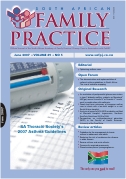An evaluation of postprandial glucose excursions in type 2 diabetic mellitus subjects on Monotard® HM (ge) versus Humulin N® or Humulin L® insulin, each in combination with metformin.
Keywords:
Postprandial glucose levels (PPG), Monotard®, Humulin N®, Humulin L®, Postprandial hyperglycaemia.
Abstract
Background There is increasing evidence that postprandial hyperglycaemia is implicated in the development of macro- and microvascular diabetic complications. Thus, control of postprandial glucose levels (PPG), in addition to control of fasting blood glucose (FBG), will ensure overall glycaemic control in diabetic patients. This study evaluated the effectiveness of a current anti-diabetic regimen on PPG in patients with type 2 diabetes mellitus. Methods A total of 31 type 2 diabetic subjects on combination treatment of either Humulin N® (HN), Monotard HM (ge)® (M) or Humulin L® (HL) insulin, with metformin, participated in a controlled, prospective, one-day visit study at a tertiary referral state diabetes clinic. The objective was to evaluate the effectiveness of the combination treatment of either M (n = 11) versus HN (n = 10) or HL (n = 10) insulin, each in combination with metformin, on PPG in this study cohort. Each subject was given a standardised meal after completing baseline procedures. Prescribed insulin doses were taken the night prior to the study day and metformin doses were taken with the standardised meal on the following morning, the study day. After completion of the meal, blood glucose levels were determined every half an hour at 0, 30, 60, 90, 120 and 150 minutes, thus providing a postprandial glucose profile for each subject. The data was analysed using ANOVA. Results The study cohort was South African, predominantly of Indian origin (54.8%), with a mean age of 59.2 ± 8 years, and 71% of the cohort was female. The subjects had a mean duration of diabetes of 11.4 ± 6.6 years, with 71% (n = 22) having a positive family history. The study cohort was obese (BMI 32.3 ± 6.2kg/m2, WHR 0.9 ± 0.1). A total of 61.3% (n = 19) of the study cohort was hypertensive, while 29% (n = 9) presented with at least one cardiovascular event and 48.3% (n = 15) had high total cholesterol. On entry to the study, the mean (± SD) FBG (10.3 ± 3.7mmol/l), fructosamine (369.9 ± 78.8mol/l) and glycosylated haemoglobin (9 ± 2%) were elevated. Each insulin group, HN, M and HL, was statistically matched for the above-mentioned and was therefore compared. There was no statistically significant difference in the effectiveness of HN, M and HL, each in combination with metformin, on postprandial glucose levels (AUC glucose 0-150 minutes was 2100, 2212.5 and 2362.5mmol.min.l-1, per group respectively). Each insulin group presented with mean postprandial hyperglycaemia (PPH) at all time intervals (30, 60, 90, 120 and 150 minutes). Peak glucose levels were observed at 90 (16mmol/l), 90 (16.9mmol/l) and 60 minutes (17.6mmol/l) for HN, M and HL groups respectively. Since there was no statistically significant difference in PPH between and amongst the insulin groups at 60, 90 and 120 minutes, an approximation of PPG at 60 minutes would not adversely affect the determination of PPG compared to the recommended two hours. Within the HN, M and HL groups, a statistically significant difference in blood glucose levels was observed at 0 and 120 minutes (p = 0.003, 0.009 and 0.019 respectively). Groups with a higher FBG (at 0 minutes) had higher PPG (at 120 minutes), thus showing that the extent of FBG determines the degree of postprandial glycaemia. Conclusion In this study, HN, M and HL, each in combination with metformin, were not effective in controlling postprandial hyperglycaemia. HN was most effective in lowering the postprandial profile, although this was not statistically significant. The current treatment of the study cohort was also reviewed, as both FBG and PPG were not controlled. The use of a combination of short/rapid-acting insulin with a newly- formulated basal insulin is recommended, as both FBG and PPG should be treated to achieve overall glycaemic control.
Published
2007-06-01
Issue
Section
Original Research
By submitting manuscripts to SAFP, authors of original articles are assigning copyright to the South African Academy of Family Physicians. Copyright of review articles are assigned to the Publisher, Medpharm Publications (Pty) Ltd, unless otherwise specified. Authors may use their own work after publication without written permission, provided they acknowledge the original source. Individuals and academic institutions may freely copy and distribute articles published in SAFP for educational and research purposes without obtaining permission.

